

Navigating Asian and American Identities. Books are like mirrors, providing readers with opportunities to see themselves in their pages, slaying dragons, braiding hair, searching for buried treasure.
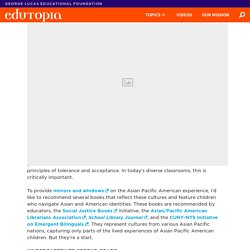
When children read books that are relevant to their lived experiences, they become more motivated to read and to use their background knowledge to better comprehend texts. It is therefore important for educators to incorporate culturally relevant books in their classrooms, so that all children can see positive representations of themselves in books. Books are also like windows, putting readers into the shoes of people whose lives are different from their own. Through culturally relevant literature, children are given access to the customs and norms of other cultures, which helps cultivate principles of tolerance and acceptance. In today’s diverse classrooms, this is critically important.
Kindergarten to Second Grade Cora Cooks Pancit by Dorina Lazo Gilmore (Filipino American): Little Cora loves helping her mother in the kitchen. A Better Way to Teach the Civil Rights Movement. A native of the Magnolia State, Jessica Dickens grew up just a short drive away from one of the most infamous events of Mississippi Freedom Summer: the 1964 disappearance and murder of three civil rights workers on their way to investigate a church burning. She’s also a graduate of one of Mississippi’s segregated high schools—part of a group of all-white private schools established in the 1950s to thwart school integration. Yet even with her personal ties to civil rights history, the central figures in Dickens’s history lessons in her early teaching years in Mississippi were Martin Luther King Jr. and Rosa Parks—two of the most memorable leaders from her own schooling, and staples of U.S. history textbooks.
It was only with exposure to fresh thinking through a teaching fellowship on civil rights history—and after uncovering her state’s untold stories—that the 11-year veteran began to shift her teaching approach. It’s a common oversight in America’s classrooms. Debunking Common Myths. Preparing for Cultural Diversity: Resources for Teachers. How can teachers effectively engage students from diverse backgrounds? It's a question many teachers face, and of course, there isn't one prescribed strategy that works. Luckily, there are many useful resources to help new and veteran educators explore the subject. If you're looking for a starting point, How Can We Prepare Teachers to Work With Culturally Diverse Students and Their Families? (an article from the Family Research Project at Harvard University) features insightful advice and useful tips from leading diversity education specialists.
These researchers agree on the underlying message that communication plays an integral role; you'll also find insight into preparation and information about connecting with students and building relationships with families. 22 Diverse Book Choices for All Grade Levels. In a vibrant, multicultural society, representing the richness of students’ lives in a class or school library takes a conscious effort. Including writers and fictional characters with a variety of backgrounds, beliefs, and life circumstances is a way to increase the chances that students will find both windows and mirrors in the library—books that reflect their lives, and ones that give them insight into the lives and experiences of people who aren’t like them.
No book shelf is going to represent the fullness of this nation. From the descendants of people who arrived here more than 15,000 years ago to the newest immigrants, we’re simply too much. Multicultural/Culturally-Responsive Books - Curriculum Collection at Lewis Library - Research Guides at Loyola University Chicago. A Guide to Selecting Multicultural Literature » African Studies Center. Introduction The language arts curriculum presents an extraordinary opportunity for sharing powerful multicultural perspectives.
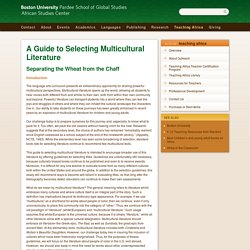
Multicultural literature opens up the world, allowing all students to hear voices both different from and similar to their own, both from within their own community and beyond. Powerful literature can transport students into a world where they can feel the joys and struggles of others and where they can inhabit the cultural landscape the characters live in. 50 Multicultural Books Every Child Should Read. This list of must-have multicultural books was originally compiled by the Cooperative Children's Book Center, School of Education, University of Wisconsin-Madison, and is reprinted here with their permission.
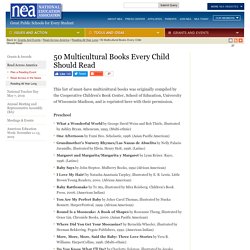
Preschool What a Wonderful World by George David Weiss and Bob Thiele, illustrated by Ashley Bryan. Atheneum, 1995. (Multi-ethnic) One Afternoon by Yumi Heo. Scholastic, 1998. Ages 5-7 Drumbeat... Ages 7-9 My Name Is Maria Isabel by Alma Flor Ada. Ages 9-12 Through My Eyes by Ruby Bridges. How to Choose Outstanding Multicultural Books.
How do you know if a children's book you're about to share with your students accurately portrays the culture of its characters?
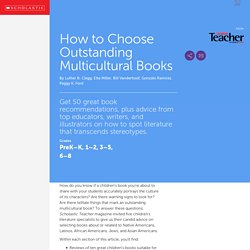
Are there warning signs to look for? Are there telltale things that mark an outstanding multicultural book? To answer these questions, Scholastic Teacher magazine invited five children's literature specialists to give us their candid advice on selecting books about or related to Native Americans, Latinos, African Americans, Jews, and Asian Americans. Within each section of this article, you'll find: ILA Bridges - Instructional Units for the Engaging Classroom. These complete literacy units, created by classroom teacher and researcher teams, give you the tools to ensure your students acquire the critical literacy skills and strategies they need for success.
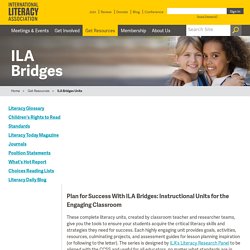
Each highly engaging unit provides goals, activities, resources, culminating projects, and assessment guides for lesson planning inspiration (or following to the letter). The series is designed by ILA's Literacy Research Panel to be aligned with the CCSS and useful for all educators, no matter what standards are in place in your district. ILA Bridges are exclusive member resources available as PDFs. Not a member?